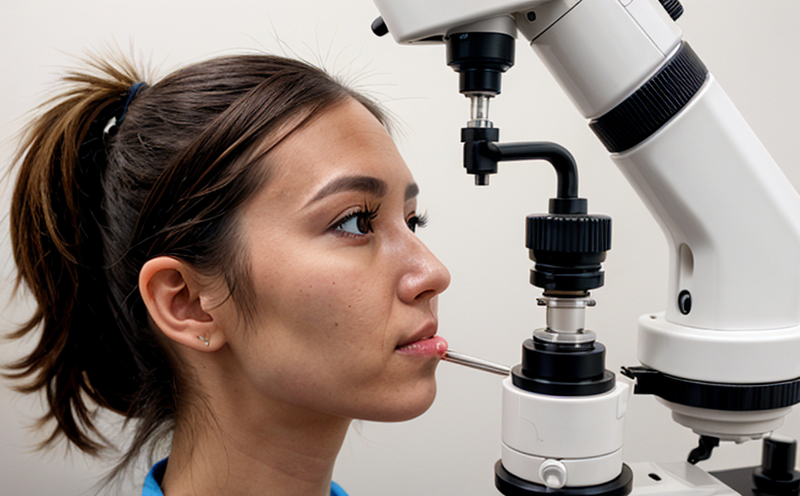ISO 18369-9 Contact Lens Surface Quality Testing
The ISO 18369 series of standards provides essential guidelines and requirements for the design, manufacture, testing, and quality assurance of contact lenses. Among these standards, ISO 18369-9:2015 specifically addresses the surface quality tests for soft contact lenses, which are crucial in ensuring the comfort, safety, and efficacy of this medical device.
The testing outlined in ISO 18369-9 is designed to evaluate various aspects of a lens’s surface characteristics. These include:
- Surface roughness
- Density of surface defects
- Surface texture
- Uniformity of the lens surface across its diameter
The goal of these tests is to ensure that contact lenses meet stringent quality standards, which directly impacts their performance and safety. The test methods described in ISO 18369-9 are intended to be reproducible and consistent, allowing manufacturers to produce lenses with uniform surface qualities.
Manufacturers must adhere to the recommendations provided in this standard during production processes to ensure compliance. Additionally, these tests serve as a critical step in quality assurance programs aimed at maintaining high standards of product safety and efficacy.
The testing process involves several steps that are meticulously outlined in ISO 18369-9:
- Sample preparation: The contact lenses must be prepared according to the specified conditions, including temperature, humidity, and storage time.
- Measurement setup: The appropriate measuring instruments such as profilometers or optical microscopes should be calibrated before use. These tools are essential for accurately assessing surface characteristics like roughness and defect density.
- Data acquisition: During this step, detailed measurements of the lens surfaces are taken under controlled conditions to ensure accuracy and repeatability.
- Data analysis: The acquired data is analyzed using statistical methods provided in ISO 18369-9. This includes calculating average roughness values (Ra) and defect density limits.
The results of these tests are critical for compliance with regulatory requirements, such as those set by the International Organization for Standardization (ISO), the United States Food and Drug Administration (FDA), and other global bodies. Compliance ensures that products meet rigorous safety and efficacy standards.
The importance of adhering to ISO 18369-9 cannot be overstated, especially for companies involved in medical device manufacturing. Not only does it help ensure the quality of contact lenses but also contributes significantly to patient comfort and overall ocular health.
Eurolab Advantages
At Eurolab, we pride ourselves on offering top-tier services tailored specifically for our clients in the medical device sector. Our expertise lies not only in adhering strictly to international standards like ISO 18369-9 but also in providing comprehensive support throughout your testing process.
- Comprehensive Testing Services: We offer a full range of contact lens surface quality tests as per ISO 18369-9, ensuring no detail is overlooked.
- Advanced Equipment: Our state-of-the-art measuring instruments ensure precise and reliable results every time. Calibration services are also available to keep your equipment in top working order.
- Expert Staff: Our team comprises highly skilled professionals with years of experience in medical device testing, ensuring that each test is conducted accurately and efficiently.
- Compliance Support: We provide guidance on how best to meet regulatory requirements, helping you navigate the complexities of global standards.
- Quick Turnaround Times: With our efficient workflow management systems, we can turn around your results faster than most competitors.
Partnering with Eurolab means more than just receiving test results—it’s about gaining access to a network of experienced professionals who understand the nuances of your industry. Together, we ensure that every aspect of your product development process meets the highest quality standards.
Quality and Reliability Assurance
The reliability and accuracy of contact lenses are paramount in maintaining patient safety and comfort. Quality assurance (QA) is a critical component of any successful medical device manufacturing company, ensuring that each product meets stringent standards set by international bodies like ISO.
- Calibration: Ensuring all measuring instruments used during testing are correctly calibrated according to manufacturer specifications ensures consistent results across multiple tests.
- Data Validation: Rigorous validation of data collected from various measurements helps identify potential discrepancies early in the process, allowing for necessary corrections before final reports are generated.
- Statistical Analysis: Utilizing statistical methods recommended by ISO standards allows for more accurate interpretation of results, providing reliable insights into any variations observed within a batch of lenses.
- Continuous Improvement: Regular review and updates to testing protocols based on feedback from both internal teams and external stakeholders help maintain cutting-edge practices in the field.
The implementation of robust QA measures ensures that every contact lens produced adheres strictly to ISO 18369-9 requirements. This not only enhances product quality but also builds trust with healthcare providers and patients alike.
Use Cases and Application Examples
Contact lenses are widely used in ophthalmic care, offering clear vision correction for millions of people worldwide. Ensuring the highest standards of surface quality is essential to maintaining patient comfort and safety. Here are some practical applications where ISO 18369-9 testing plays a vital role:
- Development Stage: During product development, ISO 18369-9 tests help identify potential issues early on, allowing for necessary adjustments before mass production begins.
- Manufacturing Process: Continuous monitoring using these tests ensures that all batches consistently meet quality standards throughout the manufacturing process.
- Quality Control: Post-production testing helps catch any deviations from expected specifications, ensuring only high-quality products reach market shelves.
- Risk Management: By identifying surface irregularities early in production cycles, potential risks to patient health can be mitigated effectively.
In addition to these direct benefits, adherence to ISO 18369-9 also enhances brand reputation and consumer confidence. Consumers know that when they choose a particular contact lens product, they are receiving something proven safe and effective through rigorous testing procedures.





